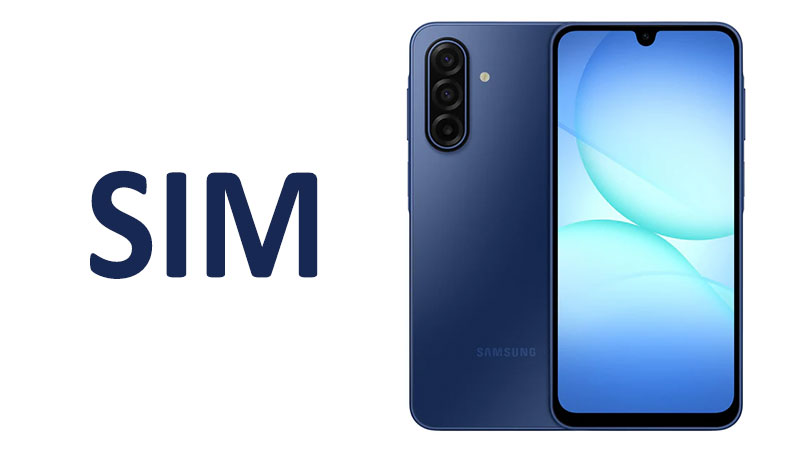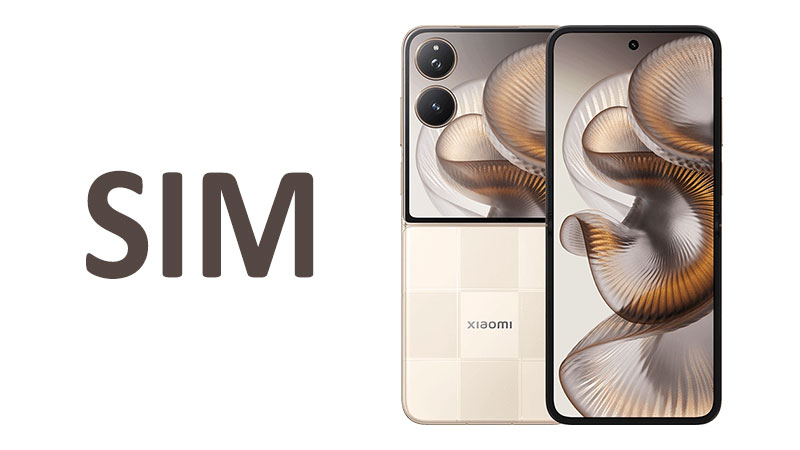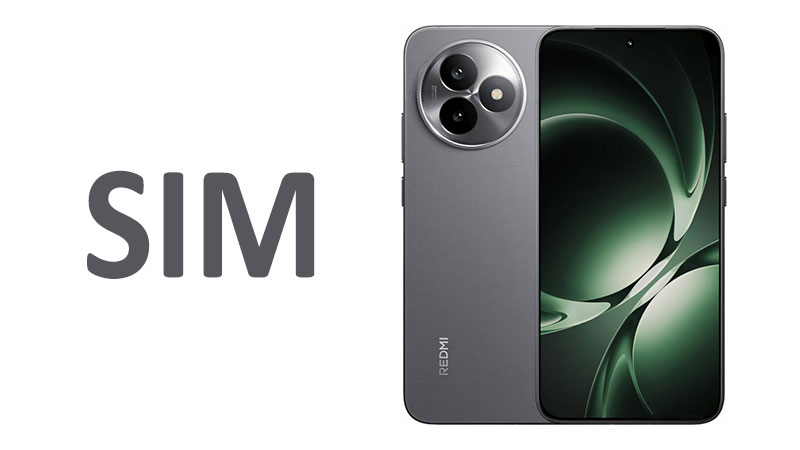The Samsung Galaxy A17 SIM configuration is a vital feature for modern smartphone users. Understanding its flexible dual-SIM and eSIM capabilities is crucial. Connectivity defines the overall experience of any mobile device. This popular budget smartphone offers several advanced networking options. It provides a versatile solution for managing multiple phone lines effectively. We will thoroughly review the Samsung Galaxy A17’s SIM tray and digital eSIM integration. Furthermore, we will analyze its comprehensive suite of connectivity standards. This includes 5G cellular speed and the latest Bluetooth 5.3 technology. This detailed guide assists buyers in making an informed purchasing decision. It focuses on the crucial aspects of mobile communication.
SIM Configuration: The Triple Flexibility Model
The Samsung Galaxy A17 features an adaptable SIM system. It caters to diverse user needs across different global markets. This flexibility is achieved through several configuration options. Buyers must understand which specific setup their region supports. The A17 allows for various combinations of physical and digital lines. This ensures widespread usability and convenience for many consumers.
Physical Nano-SIM and Dual-SIM Slots
The base configuration supports a single physical Nano-SIM card. This is standard for any basic smartphone. However, many regions will offer a Dual Nano-SIM variant. This allows users to insert two physical Nano-SIM cards simultaneously. This dual physical option remains highly popular globally. It lets users easily separate their work and personal calls. It also enables using two different mobile carriers for better coverage. This dual physical setup is straightforward and familiar to most users.
Pros and Cons of Dual Physical SIM
A significant advantage is its simplicity and universal acceptance. Physical SIM cards are easy to swap when traveling quickly. They function reliably across every mobile network worldwide. A drawback is the requirement for physically managing two small cards. Losing or damaging a card interrupts service immediately. Also, the SIM tray uses internal space within the phone’s compact design. This physical configuration is practical but less convenient than digital alternatives.
eSIM Integration and Digital Profiles
The Samsung Galaxy A17 introduces modern digital flexibility. It supports the embedded SIM, known as eSIM, in many markets. This is a significant feature for a phone in this price segment. The eSIM is a chip integrated directly into the phone’s hardware. It eliminates the need for a removable plastic card entirely. Users simply download a digital profile from their service provider. This digital setup offers enhanced convenience and security.
The Combination Setup
The A17 offers two primary dual-line configurations. The first is the traditional Nano-SIM and Nano-SIM. The second is the Nano-SIM plus one active eSIM profile. Importantly, the Galaxy A17, like most Samsung devices, only supports two active lines. This is true regardless of the chosen combination. You can manage multiple stored eSIM profiles if available. Only one eSIM can operate concurrently with the physical SIM. This versatility ensures users can always choose their preferred line type.
Important Points for Buyers
Buyers must verify if their local version includes eSIM support. Samsung often varies eSIM availability by region or carrier partnership. If the version supports eSIM, users gain substantial travel benefits. They can keep their home Nano-SIM active for calls. They can use the eSIM slot for an affordable local data plan abroad. This prevents costly international roaming charges effectively. Understanding the local model’s specific configuration is absolutely essential.
Specialized Comparison: A-Series eSIM Adoption
The inclusion of eSIM in the Galaxy A17 marks a continued trend for Samsung. Historically, eSIM was exclusive to the flagship Galaxy S and Z series phones. Its presence in the mid-range A-series democratizes this advanced feature. Many budget competitors still only offer Dual Nano-SIM trays. The A17’s support for Nano-SIM + eSIM provides a clear advantage. It offers superior line management flexibility than many phones in its class. This feature makes the A17 an excellent value proposition for frequent travelers. It matches the flexibility found in much more expensive devices.
Cellular Connectivity: Powering the 5G Experience
The Samsung Galaxy A17 supports a comprehensive range of cellular standards. This suite of technologies ensures broad compatibility globally. Crucially, the device is fully equipped with advanced 5G capabilities. This positions the A17 for high performance in the modern network environment.
5G Speed and Enhanced Latency
The Galaxy A17 fully supports the current 5G cellular standard. This capability grants access to incredibly fast mobile data speeds. 5G significantly improves upon older 4G LTE performance metrics. Users will experience rapid download and upload times for large files. This speed is vital for downloading entire movies or large application updates. Furthermore, 5G technology minimizes network latency effectively. Low latency is a requirement for competitive mobile gaming and cloud computing services. The A17’s 5G connectivity is robust and generally reliable.
Comprehensive Backward Compatibility
While 5G is the priority, reliable connectivity depends on backward support. The Galaxy A17 seamlessly operates on all older network standards. It supports LTE (4G) for fast data when 5G is unavailable. It also maintains support for HSPA (3G) and GSM (2G) networks. This wide range ensures continuous voice calling and messaging service. The phone automatically selects the best available network consistently. This prevents communication breakdowns in remote or developing areas. This full compatibility is necessary for global mobile usage.
Specialized Comparison: Budget 5G vs Flagship 5G
The Galaxy A17 uses a 5G modem optimized for cost and efficiency. Flagship phones often include support for faster mmWave 5G bands. These bands offer extreme, but highly localized, speeds. The A17 likely focuses on the more common and reliable Sub-6 GHz 5G bands. Sub-6 GHz provides wider geographic coverage and better indoor penetration. This pragmatic choice ensures a more consistent 5G experience for the average user. It balances performance with the real-world connectivity needs of the A-series segment. The speed is excellent, but not the absolute maximum theoretical rate.
Pros and Cons of 5G in the A17
A key pro is its future-proofing capability. Owning a 5G device is essential for the coming years of network evolution. The speed and low latency significantly improve the mobile experience. A con is that 5G coverage remains incomplete in many areas globally. Users in those regions will frequently rely on the 4G LTE network instead. However, the comprehensive LTE support minimizes any noticeable service gap. Overall, 5G is a huge net positive for the device.
Dual-SIM Data Management
When using two active lines, the A17 manages data traffic efficiently. Users can easily select which active SIM card handles 5G mobile data. This allows users to utilize the plan with the largest data allowance. The second SIM can remain active for calls and texts over the 4G network. This intelligent system optimizes usage and helps control data costs. Switching the primary data SIM is simple and quick through the settings menu.
Wireless Connectivity: Wi-Fi 5 and Bluetooth 5.3
Beyond cellular networks, the Samsung Galaxy A17 features strong local wireless connectivity. It integrates mature, high-performance Wi-Fi and Bluetooth standards. These are essential for daily interaction and internet access at home.
Wi-Fi 5 (802.11ac) Dual-Band
The device supports Wi-Fi up to the 802.11ac standard, commonly known as Wi-Fi 5. Wi-Fi 5 is a mature and highly reliable wireless protocol. It supports dual-band operation, using both 2.4 GHz and 5 GHz frequency bands. The 5 GHz band provides significantly faster data speeds. This is perfect for demanding activities like 4K video streaming. The 2.4 GHz band offers a wider range and better wall penetration. This ensures a consistent connection throughout an entire home or office space.
Wi-Fi Direct Functionality
The A17 also supports Wi-Fi Direct. This feature allows devices to connect to each other directly. They bypass the need for a central Wi-Fi router entirely. Wi-Fi Direct is highly useful for fast, local file sharing between phones. It is also often used for connecting to wireless printers easily. This adds a layer of convenience for local data exchange. It offers a much faster transfer speed than Bluetooth for large files.
Specialized Comparison: Wi-Fi 5 vs Wi-Fi 6
Many flagship and upper mid-range competitors now feature Wi-Fi 6 (802.11ax). Wi-Fi 6 offers increased efficiency and speed in crowded network environments. It uses advanced technology to handle numerous connected devices better. The A17’s Wi-Fi 5 is a reliable, established standard. It provides excellent speed for the average user and a single connection. The lack of Wi-Fi 6 is a minor cost-saving measure. It is a reasonable trade-off in the Galaxy A17’s segment. Only power users in heavily congested areas will truly miss Wi-Fi 6 features.
Bluetooth 5.3 for Peripherals
The Galaxy A17 is equipped with the modern Bluetooth 5.3 standard. This is a crucial component for wireless accessory use. Bluetooth 5.3 offers significant improvements over older versions. It enhances connection stability and overall energy efficiency. This is vital for maintaining reliable connections with low-power accessories.
A2DP and LE Profiles
Bluetooth 5.3 fully supports the A2DP and LE profiles. A2DP ensures high-quality audio streaming to headphones and speakers. This guarantees clear and rich sound for all media playback. LE (Low Energy) optimizes power consumption for smartwatches and fitness trackers. These devices can maintain a continuous connection without draining the battery excessively. Bluetooth 5.3 provides a noticeably improved and stable accessory experience.
Global Positioning: High-Precision Navigation
Accurate satellite positioning is a non-negotiable feature for modern smartphones. The Samsung Galaxy A17 includes a highly capable multi-constellation system. This ensures reliable and fast location services for navigation.
Multi-Constellation Support Defined
The phone supports five major global and regional navigation systems. These include GPS (United States), GALILEO (Europe), GLONASS (Russia), BDS (China), and QZSS (Japan). This is an extensive level of support for a mid-range device. Using multiple constellations simultaneously increases the number of visible satellites. This redundancy significantly improves location accuracy and speed. It ensures a quick, reliable position lock in most conditions.
Real-World Impact on Navigation
This multi-system support provides superior real-world performance. Navigation applications perform more reliably in dense urban environments. Tall buildings often block signals, but the multiple systems compensate. Geo-tagging of photos and videos is more precise in location data. Location-based services operate smoothly and consistently. The phone’s navigation performance is very strong for its market segment. It provides world-class accuracy for daily commuting and travel.
Pros and Cons of Multi-GNSS
A major pro is the exceptional reliability and speed of the location fix. Users rarely wait for the phone to establish its position. The accuracy is excellent for general navigation needs. A con is the lack of specific dual-band GPS confirmation. Dual-band (L1+L5) can reduce positional errors even further. However, the sheer number of supported constellations largely mitigates this single-band limitation. The A17 offers high-end performance in location tracking.
Auxiliary Connectivity and Physical Ports
The Samsung Galaxy A17 rounds out its connectivity with several practical features. These auxiliary tools enhance the device’s utility in various daily scenarios. They address needs beyond the core data and calling functions.
NFC Capability for Convenience
The device includes Near Field Communication (NFC) capability. This allows for quick, secure contactless payment transactions. Users can utilize services like Samsung Pay or Google Pay instantly. NFC also facilitates rapid pairing with compatible Bluetooth accessories. It enables reading NFC tags, like those used on public transit systems. Note that NFC availability can depend on the specific market or region. Most major global markets will include this expected feature.
USB Type-C 2.0: Charging and Data
The Galaxy A17 uses a modern USB Type-C port. This reversible connector is the industry standard for charging and data transfer. The port operates using the USB 2.0 protocol. USB 2.0 provides standard data transfer speeds. It ensures reliable charging performance and compatibility. The Type-C connector is durable and universally adopted today.
Specialized Comparison: USB 2.0 Speed
Many expensive competitors now feature the much faster USB 3.x standards. These ports offer dramatically quicker wired data transfer rates. The A17’s use of USB 2.0 is a noticeable compromise. Transferring massive video files via cable will take longer than on a flagship phone. However, for the majority of users who rely on wireless transfer, USB 2.0 is completely sufficient. This choice helps to keep the manufacturing cost down. The convenience of the Type-C shape is the primary benefit here.
The Absence of an FM Radio
The specifications confirm that the Samsung Galaxy A17 does not include a dedicated FM radio tuner. This exclusion is standard practice for most modern smartphones. Users must rely on streaming applications for radio content instead. These apps require a continuous cellular or Wi-Fi data connection always. This is a minor consideration for most, but relevant for users in remote areas. It is an expected trade-off in this market segment.
Conclusion
The Samsung Galaxy A17 SIM and connectivity features are impressively versatile. The flexible SIM configuration is a major selling point for this mid-range phone. Buyers can choose between Dual Nano-SIM or the modern Nano-SIM plus eSIM setup. This blend offers superior flexibility for travelers and professionals. The inclusion of 5G cellular capability future-proofs the device effectively. Dual-band Wi-Fi 5 and the latest Bluetooth 5.3 provide stable local connections. Furthermore, the five-constellation GPS support ensures highly accurate navigation worldwide. While it uses the slower USB 2.0 standard, this compromise is reasonable for the price. The Galaxy A17 provides a fast, dependable, and globally compatible connectivity package. It offers advanced features once reserved only for premium flagship models. This phone is an excellent choice for users seeking maximum connectivity flexibility and performance.
Frequently Asked Questions (FAQ)
1. Does the Samsung Galaxy A17 support dual lines?
Yes, the Samsung Galaxy A17 supports two active lines simultaneously. This can be either two Nano-SIM cards or one Nano-SIM plus one eSIM.
2. Can I use two eSIM profiles at once?
No, the Galaxy A17 supports only one active eSIM profile at any given time. This profile can be used alongside one physical Nano-SIM card.
3. What Wi-Fi standard is featured on the A17?
The phone uses the Wi-Fi 5 standard, also known as 802.11ac. It operates across the stable 2.4 GHz and the faster 5 GHz dual bands.
4. What is the speed of the USB port?
The phone uses a USB Type-C port that operates on the USB 2.0 standard. This provides reliable charging but standard data transfer speeds.
5. Does the phone’s NFC feature work globally?
NFC is included for contactless payments and pairing. However, its availability may vary slightly depending on the specific region or market where the phone is purchased.



